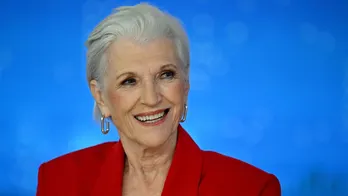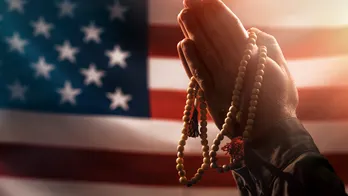What is a walking school bus? Hint: It has no tires but lots of feet and lots of soul
When Aaron Friedland was entering a master's program in economics at the University of British Columbia about a decade ago, he decided to research how the distance to school impacts attendance rates. So he spent two months living in a rural community in Uganda, regularly trekking with a group of kids who walked five miles each day round trip for their education. He still remembers that first morning, taking a boda boda motorcycle taxi at 6:30 a.m. past fields of maize to meet them at a fork in the iron-rich red road.
"Jacob was the first to arrive. He was 12 and the pack leader," Friedland says. Several other kids in backpacks appeared and they started their walk — with Friedland wearing sturdy boots and all the students in sandals made from recycled car tires.
"Jacob scurries off, hops over a barbed wire fence and runs into a corn field to a large mango tree. I see mangoes dropping, and then he comes back with a large grin and passes everyone a mango." It was a sweet gesture but also a reminder that kids with this grueling commute need extra food so they don't arrive at school hungry and not in the best condition to learn.
The experience resulted in a lot more than that planned research paper. ("The longer the distance, the more likely you are to miss school," Friedland confirms.) He founded a nonprofit he called The Walking School Bus, dedicated to improving access to education, and he started an Indiegogo crowdfunding campaign to publish a children's book he wrote with the same title.
Set in South Africa, where his parents lived until moving their family to Canada when Friedland was one, his story follows siblings Shaka and Nandi. Their father must take a mining job far away for several months and their mother's work keeps her in their village. So the kids have no one to walk them to school. The trip is long, and thieves sometimes hide under a bridge along the way, making it too dangerous for just two kids. Bored at home, they discover a toy school bus in the sand, which inspires them to try to build their own. They finally succeed when they realize they can find safety in numbers with other kids and form a walking school bus.
Over the past few years, the nonprofit took off. Now called the Simbi Foundation, for the name of a reading app Friedland developed, it helps thousands of young people learn in Uganda and India through the deployment of shipping containers that have been turned into solar-powered classrooms.
The book, however, never made it into print — until this year. That original text was an unwieldy 128 pages when Friedland brought it to the publisher Greystone Books. "They said, 'It's a great idea, but no,'" explains Friedland, who needed to figure out how to rewrite it in a more accessible format.
A solution emerged when he connected with Ndileka Mandela, the granddaughter of Nelson Mandela and head of the Thembekile Mandela Foundation, which supports education and health in rural South Africa. The story resonated with her, and they joined forces on a new version.
"So much of her experience colors and flavors the book," Friedland says, pointing to the use of several words in Xhosa, her native language. (A quick lesson in the intro explains that "umama" means "mother" and "ubaba" means "father.") Illustrations are by artist Andrew Jackson Obol, who was born and raised in Uganda.
I wondered what kids who have an easy commute to school would think of The Walking School Bus. I asked my 8-year-old American daughter — who only needs to walk 10 minutes to her elementary school — to read it. Her reaction: "What I think I learned the most is probably that kids can be very, very, very imaginative and creative, and sometimes you just need more people to be able to get where you want to go. Those kids were really willing to go out of their way to get some education."
She also wanted to ask Friedland a few things, like, how did a toy school bus end up in the sand? Maybe some kid got tired of it, he said. Here are her other questions and Friedland's answers.
Why don't Shaka and Nandi go to a school that's closer?
"Schools pop up in areas that the majority of the population can go to," he explains. So in a rural area, there might only be a few kids who live within a mile of each other. It's just not practical to create a separate school for them, says Friedland, who notes that communities often need to pool funds so more kids have access to books and other resources.
What would happen if a kid misbehaved on the walk?
Thinking back on his experience in Uganda, Friedland believes that the group dynamic limited any potential naughtiness. "If Jacob were to bully or trip one of the kids, they would have told the parents and I think he'd be booted out of the walking school bus," he says.
Who are the thieves in the story and why would they target kids?
In "The Walking School Bus," thieves wait under a bridge along Shaka and Nandi's route. Unfortunately, Friedland says, that's a common occurrence in many places. "I think what you'll see globally is that kids walk to school with items like food and backpacks and they're easier to steal from. I don't think thieves are thinking, 'I could be changing the trajectory of a kid's life,'" he says. For Friedland, the thieves also represent other difficulties that can be obstacles for kids, such as dangerous river crossings, or people who don't believe girls should get an education.
Does it cost Shaka and Nandi money to go to school?
"Yes, in rural Uganda as well as South Africa, schools require a small amount of money," Friedland says. And for some kids, that cost can be too high, which means their families don't send them to school. So one way to help even from far away, he adds, is to sponsor scholarships.
Vicky Hallett is a freelance writer who regularly contributes to NPR.
Disclaimer: The copyright of this article belongs to the original author. Reposting this article is solely for the purpose of information dissemination and does not constitute any investment advice. If there is any infringement, please contact us immediately. We will make corrections or deletions as necessary. Thank you.







